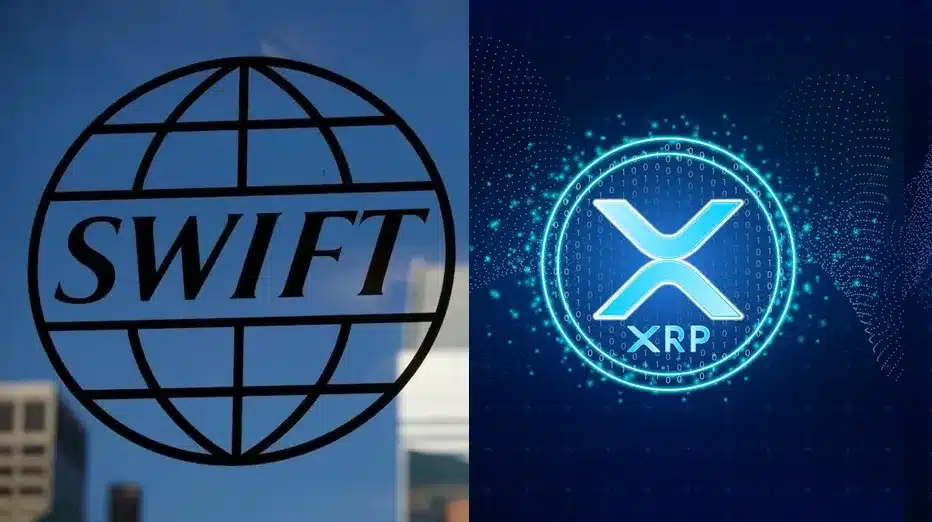A heated discussion on X (formerly Twitter) drew attention to how major blockchain platforms, specifically Ripple and Chainlink, are mentioned across different sections of SWIFT’s official content.
The debate, sparked by a post from a crypto user named Shane and followed up by blockchain researcher SMQKE, provides a compelling snapshot of how fragmented interpretations can create confusion in crypto circles.
Chainlink’s Role in SWIFT’s Project CALM Raises Eyebrows
Shane’s tweet centered around a screenshot from SWIFT’s coverage of Project CALM (Corporate Actions Lifecycle Management), an initiative aimed at modernizing back-office processes for financial institutions using technologies such as blockchain and artificial intelligence.
A portion of the screenshot highlights SWIFT’s emphasis on its collaboration with Chainlink and other stakeholders in the industry.
Shane’s tweet also included the line, “I don’t see $XRP anywhere,” followed by the declaration: “$Link ˣ SWIFT,” implying that Chainlink has a formalized role in SWIFT’s evolving blockchain strategy while Ripple is noticeably absent.
Also Read: Ripple’s XRP Poised to Power Future of Banking as Santander Unveils 2030 Plan
Researcher Counters: Ripple Also Gets a Mention—Just Not Here
SMQKE, a well-regarded blockchain researcher, replied with a different quote from SWIFT’s official website, pointing out that Ripple is indeed referenced within other sections of the organization’s communications. Citing a prior SWIFT publication, SMQKE highlighted this passage:
“Wells Fargo is looking at this area, using Ripple, as are lots of other banks.”
This quote came from an event transcript hosted on swift.com that discussed blockchain adoption within financial institutions. The same transcript also included a comment from Epiphyte’s Patrick Murck, stating:
“Our technology allows fiat and crypto-currencies to exist in parallel.”
These remarks place Ripple firmly within the context of experimentation and evaluation by financial giants, even if it isn’t currently featured in SWIFT’s newer pilot programs like Project CALM.
Separate Use Cases, Separate Spotlights
The apparent discrepancy isn’t a contradiction, just a matter of context. SWIFT’s partnership with Chainlink is part of an active proof-of-concept and pilot phase aimed at real-time interoperability between blockchains and traditional finance networks.
Chainlink Labs confirmed its role in integrating CCIP (Cross-Chain Interoperability Protocol) with SWIFT’s messaging system during last year’s Sibos conference.
Ripple, on the other hand, is referenced in SWIFT’s earlier documentation in connection with broader industry adoption of distributed ledger technology (DLT).
Banks like Santander and Wells Fargo have been experimenting with RippleNet and On-Demand Liquidity (ODL) solutions for cross-border payments, areas SWIFT has long sought to modernize but approached with more institutional conservatism.
A Broader Take on SWIFT’s Blockchain Strategy
It’s worth noting that SWIFT has historically positioned itself as platform-neutral when exploring digital innovation. Its long-term approach appears to be focused on modularity, partnering with various technologies to test specific components of financial messaging, liquidity management, and compliance automation.
While Chainlink is leading in SWIFT’s current tokenization and automation pilot, Ripple remains one of the key technologies mentioned in earlier research and development phases.
That does not diminish Ripple’s role; rather, it speaks to the layered and multi-pronged approach financial infrastructure providers like SWIFT are taking.
Market Reaction: Focus Shifts Back to Interoperability
The conversation between Shane and SMQKE echoes a wider industry concern: who will become the de facto bridge between crypto and traditional finance? The SWIFT-Chainlink pilot has added fuel to Chainlink’s narrative as a leader in enterprise-grade interoperability.
However, Ripple continues to maintain its stronghold in cross-border settlements, recently expanding ODL corridors in Asia and the Middle East.
Ripple’s CLO, Stuart Alderoty, and CEO, Brad Garlinghouse, have repeatedly emphasized the company’s focus on regulatory clarity, especially in the U.S., where its legal battles with the SEC continue to shape its roadmap.
Meanwhile, Chainlink has largely avoided regulatory entanglements, allowing it to scale pilot programs with less friction.
Conclusion
The Twitter exchange may have been brief, but it exposed a much larger reality: the institutional crypto landscape is not binary. Both Chainlink and Ripple are playing distinct but significant roles in the modernization of global finance.
SWIFT’s platform reflects this dual-track strategy, leveraging multiple blockchain tools to test what works best in different use cases.
As the industry evolves, so too will the players leading the charge, and while they may not always appear in the same press release, both Chainlink and Ripple are very much in the game.
Also Read: Prominent American Millionaire Reveals Surprising Reason Why He Invested in XRP

